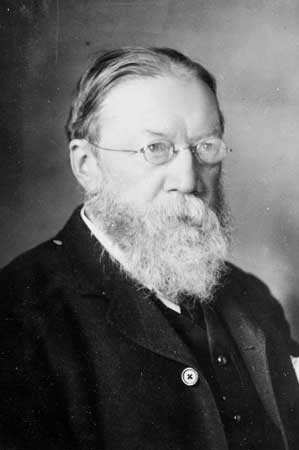William Henry Preece facts for kids
Quick facts for kids
William Henry Preece
|
|
|---|---|

William Henry Preece
|
|
| Born | 15 February 1834 Caernarfon, Gwynedd, Wales
|
| Died | 6 November 1913 (aged 79) |
| Education | King's College London |
| Occupation | Engineer |
| Engineering career | |
| Discipline | Civil, Electrical, |
| Institutions | British Association for the Advancement of Science (president, Section G), Institution of Civil Engineers (president), Institution of Electrical Engineers (president), Society of Telegraph Engineers (president) |
Sir William Henry Preece (born February 15, 1834 – died November 6, 1913) was a Welsh electrical engineer and inventor. He was known for using experiments and practical thinking in his work. When he retired from the Post Office in 1899, he received a special honor, becoming a Knight Commander.
About William Henry Preece
Preece was born in Caernarfon, Gwynedd, Wales. He went to school at King's College School and King's College London. He learned from the famous scientist Michael Faraday at the Royal Institution in London. Later, he became a top engineer for the British Post Office. He was named Engineer-in-Chief in 1892.
Preece made important improvements to railway signaling systems. These changes helped make train travel much safer. He also had some disagreements with another scientist, Oliver Lodge, about how electricity worked.
Working with Telegraphs
In 1889, Preece and his team did an amazing experiment. They were at Coniston Water in the Lake District in England. They managed to send and receive Morse code signals without wires. The signals traveled about 1 mile (1.6 km) across the water.
Preece also helped create a wireless telegraph and telephone system in 1892. He put a telephone system into use in England. A similar telephone system was invented in the United States by Alexander Graham Bell in 1876.
In 1885, Preece worked with Arthur West Heaviside. Arthur was the brother of the famous scientist Oliver Heaviside. They experimented with telegraph lines and a special telephone receiver. They discovered something called radio induction. This is related to how signals can "cross-talk" between lines.
Preece and Oliver Heaviside had a long-standing rivalry. Heaviside thought Preece wasn't very good at math. Some people believed Preece tried to stop Heaviside's work from being published. This was likely to protect Preece's own reputation.
Preece's Work with Radio
In 1897, Preece became a big supporter of Guglielmo Marconi. Marconi was doing important radio experiments in south Wales. Preece helped Marconi get money from the Post Office to expand his work. Preece believed that the Earth's magnetic field was very important for sending radio waves over long distances. However, this idea was later found to be incorrect.
Preece had a different way of thinking about electricity than some other scientists. He often used simple comparisons, like comparing electricity to water flowing through pipes. This idea was sometimes called the "drain-pipe theory" by Oliver Heaviside. Preece also didn't seem to fully understand the new ideas from James Clerk Maxwell about how electricity and magnetism work together.
In 1893, when Preece was president of the Institution of Electrical Engineers, he gave a speech. He said that true scientific ideas don't need complicated math to be understood. He believed that practical science should be clear and easy to apply.
Preece also served as the president of the Institution of Civil Engineers. He held this position from April 1898 to November 1899.

